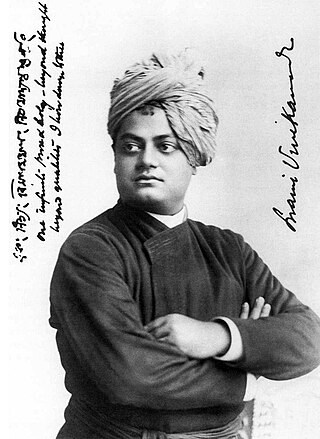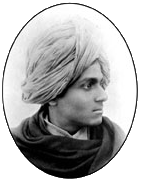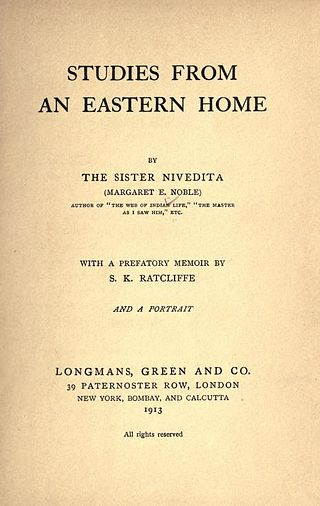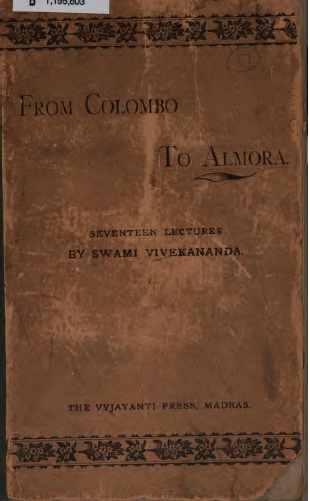
Swami Vivekananda, born Narendranath Datta, was an Indian Hindu monk, philosopher, author, religious teacher, and the chief disciple of the Indian mystic Ramakrishna. He was a key figure in the introduction of Vedanta and Yoga to the Western world, and the father of modern Indian nationalism who is credited with raising interfaith awareness and bringing Hinduism to the status of a major world religion.

Sister Nivedita was an Irish teacher, author, social activist, school founder and disciple of Swami Vivekananda. She spent her childhood and early youth in Ireland. She was engaged to marry a Welsh youth, but he died soon after their engagement.

Prabuddha Bharata is an English-language monthly journal of the Ramakrishna Order, in publication since July 1896. It carries articles and translations by monks, scholars, and other writers on humanities and social sciences including religious, psychological, historical, and cultural themes. It has a section of book reviews where important publications from university presses from around the world are reviewed. It is edited from Advaita Ashrama, Mayavati, Uttarakhand, and published and printed in Kolkata. Prabuddha Bharata is India's longest running English journal.

Advaita Ashrama, Mayavati, is a branch of the Ramakrishna Math, founded on 19 March 1899 at the behest of Vivekananda, by his disciples James Henry Sevier, and Charlotte Sevier. Today it publishes the original writings of Vivekananda. As an ashram dedicated to the study and practice of Advaita Vedanta, no images or idols are worshipped there, not even of Ramakrishna; and no images were kept in the premises according to the Ashram ideals set by Vivekananda.

Sister Gargi, born Marie Louise Burke, was a writer and an eminent researcher on Swami Vivekananda, and a leading literary figure of the Ramakrishna-Vivekananda movement. Gargi was introduced to the Ramakrishna-Vivekananda movement in 1948 by Swami Ashokananda. She is known for her six-volume work, Swami Vivekananda in the West: New Discoveries. Her New Discoveries are considered as indispensable for Swami Vivekananda research.

Swarupananda was a direct monastic disciple of Vivekananda and the first president of the Advaita Ashrama, set up by Vivekananda in 1899 at Mayavati, near Champawat. The ashram is a branch of the religious monastic order, Ramakrishna Math, also set up by Vivekananda on the teachings of his guru Ramakrishna.
Ramakrishna Sarada Mission Sister Nivedita Girls' School or Sister Nivedita Girls' School is a girls' school at Bagbazar, North Kolkata. It was established by Scottish-Irish social worker, author, speaker and disciple of Swami Vivekananda, Sister Nivedita, in November 1898.

Josephine MacLeod was an American friend and devotee of Swami Vivekananda. She had a strong attachment to India and was an active participant in the Ramakrishna Vivekananda movement. She was given the nicknames "Tantine" and "Jo Jo" by Vivekananda. She considered Swami Vivekananda to be her friend and helped him with his finances. MacLeod was not a sanyasin, unlike many others such as Sister Nivedita or Sister Christine. She was instrumental in spreading Vivekananda's message on Vedanta in the West. She made many contributions to the initial and the later phases of the development of the order of Ramakrishna and Vivekananda. She was a contributor to many causes espoused by Sister Nivedita, the most famous disciple of Vivekananda, including that of contributing financially towards the development of the Indian National Movement especially in Bengal and elsewhere in India.

Cradle Tales of Hinduism (1907) is a collection of stories by Sister Nivedita. It is an introduction to Hindu mythology; the stories come from the Mahabharata, the Ramayana and other Hindu sources and are presented as they were told in Indian nurseries.

An Indian Study of Love and Death (1908) is a book written by Sister Nivedita.

Myths of the Hindus & Buddhists (1913) is a book written by Sister Nivedita and Ananda K. Coomaraswamy.

Studies from an Eastern Home (1913) is an autobiographical book written by Sister Nivedita.

Select Essays of Sister Nivedita (1911) is an English-language book written by Sister Nivedita, a disciple of Swami Vivekananda. The foreword of the book was written by A. J. F. Blair.

Swami Vivekananda (1863–1902) was an Indian Hindu monk and a key figure in the introduction of Indian philosophies of Vedanta and Yoga to the western world. He was one of the most influential philosophers and social reformers in his contemporary India and the most successful and influential missionaries of Vedanta to the Western world. Indian Nobel laureate poet Rabindranath Tagore's suggested to study the works of Vivekananda to understand India. He also told, in Vivekananda there was nothing negative, but everything positive.

Lectures from Colombo to Almora (1897) is a book of Swami Vivekananda based on the lectures he delivered in Sri Lanka and India after his return from the West. Vivekananda reached Colombo, British Ceylon on 15 January 1897. After delivering lectures in Colombo and Jaffna, Vivekananda arrived at Pamban in South India. A forty-feet high monument was built by the king of Ramnad, Bhaskara Sethupathi, on the spot where he landed to celebrate his achievements at the West. Vivekananda travelled extensively and visited many Indian states delivering lectures on a variety of topics. On 19 June 1897, he reached Almora. The lectures delivered by him in this period were compiled into the book Lectures from Colombo to Almora.

"Kali the Mother" is a poem written by Hindu monk Swami Vivekananda. Vivekananda wrote the poem on 24 September 1898 when he was staying in Kashmir, on a houseboat, on Dal Lake in Srinagar. In this poem he worshipped goddess Kali.

"To the Fourth of July" is an English poem written by Indian monk and social reformer Swami Vivekananda. Vivekananda wrote the poem on 4 July 1898 on the anniversary of the United States' independence.

Sister Christine or Christina Greenstidel was a school teacher, and close friend and disciple of Swami Vivekananda. On 24 February 1894, Christine attended a lecture of Vivekananda in Detroit, United States which inspired her. She started communicating with Vivekananda through letters. Christine went to India in 1902 and began working as a school teacher and a social worker.

Swami Sadananda, born Sharat Chandra Gupta, popularly known as Gupta Maharaj in the Ramakrishna Order, was a direct monastic disciple of Swami Vivekananda. He was the first disciple according to some sources. He took his monastic vows and joined Baranagar Math to serve the other disciples of Sri Ramakrishna in 1888–89 and subsequently joined the Belur Math when it was established. He was one of the leaders of early Ramakrishna Mission in its relief work. One of his significant contributions was providing relief to the citizens of Calcutta during the plague epidemic of 1898–99. He traveled to Japan in 1903. His later days were spent in company of Sister Nivedita as her protector and guide. His notable contribution in the later part of his life was preaching the message of Swami Vivekananda, especially among youth.
In 1888, Swami Vivekananda left the monastery as a Parivrâjaka— the Hindu religious life of a wandering monk, "without fixed abode, without ties, independent and strangers wherever they go". His sole possessions were a kamandalu, staff and his two favourite books: the Bhagavad Gita and The Imitation of Christ. Narendra travelled extensively in India for five years, visiting centres of learning and acquainting himself with diverse religious traditions and social patterns. He developed sympathy for the suffering and poverty of the people, and resolved to uplift the nation. Living primarily on bhiksha (alms), Swami Vivekananda travelled on foot and by railway. During his travels he met, and stayed with Indians from all religions and walks of life: scholars, dewans, rajas, Hindus, Muslims, Christians, paraiyars and government officials.


















